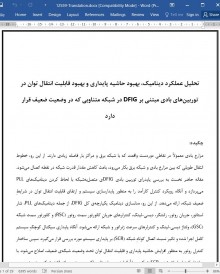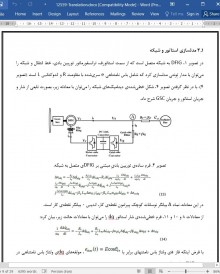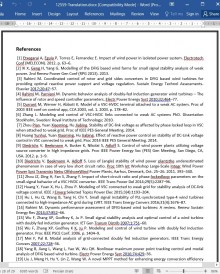
تحلیل عملکرد دینامیک، بهبود حاشیه پایداری و بهبود قابلیت انتقال توان در توربین های بادی مبتنی بر DFIG
چکیده:
مزارع بادی معمولاً در نقاطی دوردست واقعند که با شبکه برق و مراکز بار فاصله زیادی دارند. از این رو، خطوط انتقال طویلی که بین مزارع بادی و شبکه برق بکار میرود، باعث کاهش مقدار قدرت شبکه در نقطه اتصال میشود. مقاله حاضر نخست به بررسی پایدرای توربین بادی DFIGی متصلبهشبکه با لحاظ کردن دینامیکهای PLL میپردازد و آنگاه رویکرد کنترل کارآمد را به منظور پایدارسازی سیستم و ارتقای قابلیت انتقال توان در شرایطِ ضعیف شبکه، ارائه میدهد. از این رو، مدلسازی دینامیک یکپارچهی کل DFIG، از جمله دینامیکهای PLL، شار استاتور، جریان روتور، رانشگر، دیسی-لینک، کنترلرهای جریانِ کانورتور سمت روتور (RSC) و کانورتور سمت شبکه (GSC)، ولتاژ دیسی-لینک و کنترلرهای سرعت ژنراتور و شبکه ارائه میشود. آنگاه پایداری سیگنال کوچکِ سیستم کامل اجرا شده و تاثیر نسبت اتصال کوتاهِ شبکه (SCR) بر پایداری سیستم مورد بررسی قرار میگیرد. سپس ساختار کنترل روتور به منظور افزایش حاشیه پایداری و قابلیت انتقال توان تحت وضعیت شبکهی ضعیف، اصلاح میشود. با ساختار کنترل اصلاحشده، SCR شبکه مجازاً افزایش مییابد تا عملکرد سیستم در اتصالات شبکهی ضعیف بهبود یابد. سرانجام اینکه نتایج تحلیلهای نظری توسط شبیهسازی دامنه زمان که توسط محیط شبیهسازِ متلب اجرا میشود، تایید میگردد.
1. مقدمه
در توسعهی فناوری توربین بادی (WT)، انواع مختلفی از توربینهای بادی نظیر نوع سرعتثابت، نوع سرعت متغیر محدود، ژنراتور القایی با تغذیهی دوگانه (DFIG) و نوع سرعتمتغیرِ مقیاسکامل، مدنظر قرار گرفتهاند. در میان روشهای مختلف کسب سرعت متغیر، سیستم مبتنی بر DFIG-WT به روشی پرطرفدار تبدیل شده است. همانطور که در تصویر 1 مشاهده میکنید، سیمپیچ استاتور DFIG، مستقیماً به شبکه وصل است و سیمپیچ روتور از مبدلهای منبع ولتاژ پشتبهپشت (VSC) تغذیه میکند که به مبدل سمتِ روتور (RSC) و مبدل سمت شبکه (GSC)، معروفند.
در این مقاله، از آر اس سی جهت کنترل سرعت ژنراتور و ساپورت توان راکتیو و از جی اس سی برای کنترل ولتاژ دیسی-لینک و تنظیم توان راکتیو استفاده میشود. سنکرونسازی شبکه، گام مهمی برای کنترل آر اس سی جی اس سی است که بطور نرمال با استفاده از حلقهی قفلشدهی فاز (PLL) انجام میشود. این مقاله، نخست پایداری سیستم توربین بادی دی اف آی جیِ متصل به شبکه را با لحاظ کردنِ دینامیکهای پی ال ال بررسی میکند و آنگاه یک رویکرد کنترلی جدید را به منظور پایدارسازی سیستم در وضعیتی که شبکه ac ضعیف است، مدنظر قرار میدهد.
7. نتیجه
این مقاله به این مبحث میپردازد: تحلیل پایداری و ارتقای پایداری دینامیکِ توربینهای بادی مبتنی بر DFIGی متصل به شبکه، تحت شرایطی که شبکه متناوب ضعیف است. از این رو مدلسازی دینامیکِ یکپارچهی کل سیستم DFIG، از جمله دینامیک PLL، شار استاتور، جریان روتور، رانشگر، دیسی-لینک، کنترلرهای جریان RSC و GSC، ولتاژ دیسی-لینک و کنترلرهای سرعت ژنراتور و شبکه، در این مقاله ارائه میشوند. آنگاه پایداری سیگنال کوچکِ سیستم کامل، اجرا میشود و تاثیر SCR شبکه بر پایداری سیستم بررسی میگردد. نشان میدهیم که به ازای مقادر کمتر از 3 از SCR، مُدهای متناظر با ولتاژ دیسی-لینک و متعاقباً کل سیستم ناپایدار میشوند. آنگاه کنترل RSC اصلاح میشود و در آن یک مقاومت مجازی منفی به سمت استاتور معرفی میشود و به این ترتیب SCR شبکه مجازاً افزایش یافته و باعث پایداری سیستم و اتصالات شبکه ضعیف میشود. نتایج شبیهسازی تحلیلهای نظری را تایید میکنند و نشان میدهند که در SCR= 3 و در حالتی که شبیهسازی امپدانس مجازی وجود نداشته باشد، واکنشهای گشتاور الکتورمغناطیس، توان اکتیو خروجی و ولتاژ دیسی-لینک ناپایدار است و به مقادیر بسیار پایینی میرسد. از سوی دیگر، در حالتی که شبیهسازی مقاومت مجازی منفی وجود دارد، واکنشهای سیستم پایدار میشود. دلیلش این است که رویکرد کنترل اصلاحشده، مجازاً قدرت شبکه را بالا برده و متعاقباً باعث ارتقای حاشیه پایداری DFIG مو قابلیت انتقال قدرت میشود.
Abstract
Wind farms are usually located in remote areas far away from utility grid and load centers. Hence, long transmission lines, used between wind farms and utility grid, result in a low value for the grid strength at connection point. This paper first studies stability of the grid connected DFIG wind turbine taking the PLL dynamics into account, and then presents an efficient control approach to stabilize the system and to enhance transfer power capability at weak grid conditions. Hence, unified dynamic modeling of the whole DFIG, including dynamics of the PLL, stator flux, rotor current, drive train, dc-link, rotor side converter (RSC) and grid side converter (GSC) current controllers, dc-link voltage and generator speed controllers, and grid is presented. Then, small signal stability of the full system is carried out and impact of the grid short circuit ratio (SCR) on stability of the system is examined. Next, rotor control structure is modified to increase the stability margin and transfer power capability under weak grid conditions. By the modified control structure, the grid SCR is virtually increased to enhance the system performance at weak grid connections. Finally, results of theoretical analyses are verified by time domain simulations conducted in MATLAB-Simulink environment.
1. Introduction
In the development of wind turbine (WT) technology, several types of WTs such as fixed speed type, limited variable speed WT, doubly-fed induction generator (DFIG), and full-scale variable speed WT have been considered [1,2]. Among the different alternatives to obtain variable speed, the system based on DFIG-WT has become the most popular [3]. As shown in Fig. 1, the DFIG stator winding is directly connected to the grid, and the rotor winding is supplied from the back-to-back voltage source converters (VSCs), known as rotor side converter (RSC) and grid side converter (GSC).
In this paper, the RSC is used for the generator speed control, and reactive power support, and the GSC for the dc-link voltage control and reactive power regulation [4]. The grid synchronization is a main step for the control of the RSC and GSC that is normally done by using the phase locked loop (PLL). This paper first examines stability of the grid connected DFIG wind turbine system taking the PLL dynamics into account, and then proposes a new control approach to stabilize the system under weak ac grid conditions.
7. Conclusion
This paper deals with the stability analysis and dynamic stability enhancement of the grid connected DFIG based WTs under weak ac grid conditions. Hence, unified dynamic modeling of the whole DFIG system, including the dynamics of the PLL, stator flux, rotor current, drive train, dc-link, RSC and GSC current controllers, dc-link voltage and generator speed controllers, and grid is presented. Then, small signal stability of the full system is carried out and impact of the grid SCR on the stability of the system is examined. It is shown that for the SCR values lower than 3, the modes corresponding to the dc-link voltage and thus the whole system become unstable. Next, the RSC control structure is modified, in which a negative virtual inductance is introduced at the stator side, and thus the grid SCR is virtually increased that stabilizes the system at weak grid connections. Simulation results verify the theoretical analyses and depict that at SCR = 3 and in the case without the virtual impedance emulation, the responses of the electromagnetic torque, output active power and dc-link voltage are unstable and reach very low values. On the other hand, in the case with the negative virtual inductance emulation, the system responses become stable. This is because the modified control approach virtually increases the grid strength and consequently enhances the DFIG stability margin and power transfer capability
چکیده
1. مقدمه
2. سنکرونسازی DFIG و دینامیکهای PLL
3. مدلسازی دینامیکهای استاتور و روتور در توربین بادیِ مبتنی بر DFIG
3.1 مدلسازی استاتور و شبکه
3.2 مدلسازی روتور و کنترلرهای متناظر
3.3 کنترلر سرعت و توان راکتیو
3.4 مدلسازی GSC و خازنِ دیسی-لینک
4. تحلیل پایداری سیگنال کوچک
5. تغییر کنترل RSC و شبیهسازیِ امپدانس
6. نتایج شبیهسازی
7. نتیجه
منابع
ABSTRACT
1. Introduction
2. DFIG synchronization and PLL dynamics
3. Modeling of the stator and rotor dynamics in DFIG based WT
3.1. Stator and grid modeling
3.2. Modeling of rotor and corresponding controllers
3.3. Speed and reactive power controller
3.4. Modeling of the GSC and DC link capacitor
4. Small signal stability analysis
5. RSC control modification and virtual impedance emulation
6. Simulation results
7. Conclusion
References
- اصل مقاله انگلیسی با فرمت ورد (word) با قابلیت ویرایش
- ترجمه فارسی مقاله با فرمت ورد (word) با قابلیت ویرایش، بدون آرم سایت ای ترجمه
- ترجمه فارسی مقاله با فرمت pdf، بدون آرم سایت ای ترجمه



